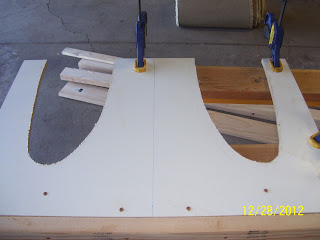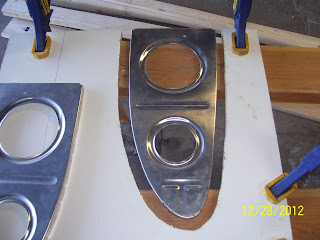It consists of a 36 inch base, and 15 inch high by 13 inch wide support brackets, spaced 26 inches apart from each other. The plans say to use 1/2 inch plywood for this cradle, but I had an abundance of 3/4 inch particle board remnant from the shed doors that I completed early this year, so I decided to use that instead. This was basically a repeat exercise that is similar to one half of the wing cradle with the cutouts for the ribs. It is configured to hold either end of the leading edge skins in place while the ribs are assembled.
It is very difficult to attach the partially bent, spring tensioned leading eadge skin just by forcing it around the ribs with your bare hands. I have a video that shows what must have been an early method of doing this where the LE ribs are attached to the main wing spar, and then the skins are attached to the top side of the ribs first, followed by the bottom side. The plans simply say to perform this same assembly by using the LE cradle to force the LE skins into the correct preliminary shape of the rib, land the ribs are clecoed together in the cradle. ALl this makes me think of is the times that attached the HS and VS skins, which were also spring tensioned by design. I sure hope I do a better job of riveting the LEs together than I did with the HS and VS.
Anyway, here is a series of pics showing the steps I took. I also deviated from the plans after reviewing many commnets on VAF complaining that vans design for the cradle appears to be unstable, which I was inclined to agree with when I realized how much force I may need to apply to get the clecos inserted correctly the first time.
First was reviewing the plan dimensions to determine how I would modify mine:
Then I set out to make the two end pieces that will be cut out to match the ribs for each leading eadge. It is hard to see my measurement markings on the wood, but the I basically used the existing width of 16 inches (Vans calls for 15, but a little more length here is actually a good thing). I did cut them to 13 inches wide per the plans. The tricky part is where to position the rib. I decided to use the rear flange of the rib and tried to align it parallel with the edge of the wood, and then I traced the rib pattern onto the wood.
Next was my modification to use 2x4s as a corner brace for each bracket:
Then I clamped each of the brackets to a wide flat piece of particle board (36 inches long x 16 inches wide). ONce each braclet was clamped to the base, I flipped this assembly over and screwed the base to the 2x4 corner supports:
And here is the finished product:
The base can then be clamped to the work bench. I may still need to sand the insides of the cutouts a little bit and put some tape or someing over the edges to prevent the skins from getting scuffed or scratched. That was enough for today, however, since the weather forecast around here for New Year's Eve is about 0 degrees. Tomorrow I will see if I can brave the cold long enough to reposition the LE skins from the shelf onto the work bench. Then I may even bring down the left wing spar to prepare for match drilling the main ribs to the wing spar.
Wishing everyone out there a safe, happy new year, hopefully filled with lots of airplane building and flying fun!


















































